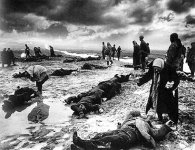lushd
Donald
I think this thread got eaten by technical problems, so here goes again. Introduce a favourite photograph. Here's one of mine:
I first saw this photograph when I was working in a public library in the early 1980’s.
We were disposing of old stock and a copy of Riefenstahls “Last of the Nuba” and “People of Kau” were in the pile. I was immediately captivated by this picture, which is on the cover of “People of Kau” and took the books home. I still have them.
Later, at college, I began to learn more about Riefenstahl and although my pleasure in this picture (and both the books) hasn’t diminished things have become a bit more complicated.
So why did this image work it’s magic on me? The easy things first, I think. Riefenstahl used Agfa colour slide film, which had a particular range of warm and muted colours that were attractive and distinctive. My own early experiments with photography were conducted with Agfa CT18 colour slide film and (Kodachrome aside) I think it’s one of the finest colour films ever made. It’s also worth mentioning that this whole series of pictures was made with a Leica rangefinder camera, a device more than capable of getting the most from the Agfa film and with a charisma all its own. I own one love using it.
Secondly, this is a beautiful image of a beautiful face. The make up and paint designs add a strong sense of otherness. This is a beautiful stranger but is no empty anthropological record shot. The sitter has an expression that invites empathy. He’s been caught in a pensive moment, which has given him dignity and a chance for viewers to think “however strange, he’s a bit like us”. I’m only human – how could I not be interested?
Which is where the deeper thinking begins for me. When Riefenstahl went to Africa to photograph her lost people, she was trying to get as far from her history as she could. I don’t think she succeeded.
She was one of the greatest artists of the 20th century and like many of her era and nationality she was totally compromised by her encounter with National Socialism. In every way she was a lucky woman – she escaped with her life and was able to pick up her career very successfully. Only her reputation was badly damaged. The tag of Nazi propagandist followed her through most of her life and she was judged accordingly, if sometimes unfairly.
So what was she up to here? And how conscious were her intentions?
Her two greatest works (the films “Triumph of the Will” and “Olympia”) showed the world clearly where her interests and those of Nazism coincided. Ideas of physical perfection, warrior nobility, victory of the strongest and politics as spectacle abound in both films.
They’re still present in her Nuba and Kau photographs. Essentially the question (uncomfortable one for the viewer who loves these pictures) is: was she a racist? Are we enjoying a rerun of the “noble savage” mythology and could these pictures be perverted into “evidence” of racial inferiority?
Nothing I have read about her suggests that she was a racist. She was never a member of the Nazi party and initially turned down the commission for “Triumph of the Will”. Hitler more or less had to order her to do it. “Olympia” was commissioned by the international Olympic committee and its production was obstructed at every turn by the propaganda ministry under Goebbels. Only when it was released did he realise how it could be exploited to further the Nazi cause. There is no evidence that she took part in or supported racist persecutions and mass murder under the Nazis.
So I think we can clear her of being a Nazi. But she was still a good old-fashioned imperialist. Her pictures of the Kau and the Nuba, however warm and sympathetic, have much in common with the imperialist passion to collect, preserve and catalogue the cultures they dominated, founded in a belief that western (white) culture was “better”.
Indeed, this very act of organising cultures according to western ideals became a means of domination in itself. This project has left us with little idea of what the Nuba and the Kau thought of her and her activities.
So the discomfort remains. Riefenstahl was a product of her breeding and her times. She turned this raw material into great art while failing to accept any responsibility for the way her work could be exploited for evil ends. The ghosts of that failure haunt all these pictures and should haunt their viewers too.
I first saw this photograph when I was working in a public library in the early 1980’s.
We were disposing of old stock and a copy of Riefenstahls “Last of the Nuba” and “People of Kau” were in the pile. I was immediately captivated by this picture, which is on the cover of “People of Kau” and took the books home. I still have them.
Later, at college, I began to learn more about Riefenstahl and although my pleasure in this picture (and both the books) hasn’t diminished things have become a bit more complicated.
So why did this image work it’s magic on me? The easy things first, I think. Riefenstahl used Agfa colour slide film, which had a particular range of warm and muted colours that were attractive and distinctive. My own early experiments with photography were conducted with Agfa CT18 colour slide film and (Kodachrome aside) I think it’s one of the finest colour films ever made. It’s also worth mentioning that this whole series of pictures was made with a Leica rangefinder camera, a device more than capable of getting the most from the Agfa film and with a charisma all its own. I own one love using it.
Secondly, this is a beautiful image of a beautiful face. The make up and paint designs add a strong sense of otherness. This is a beautiful stranger but is no empty anthropological record shot. The sitter has an expression that invites empathy. He’s been caught in a pensive moment, which has given him dignity and a chance for viewers to think “however strange, he’s a bit like us”. I’m only human – how could I not be interested?
Which is where the deeper thinking begins for me. When Riefenstahl went to Africa to photograph her lost people, she was trying to get as far from her history as she could. I don’t think she succeeded.
She was one of the greatest artists of the 20th century and like many of her era and nationality she was totally compromised by her encounter with National Socialism. In every way she was a lucky woman – she escaped with her life and was able to pick up her career very successfully. Only her reputation was badly damaged. The tag of Nazi propagandist followed her through most of her life and she was judged accordingly, if sometimes unfairly.
So what was she up to here? And how conscious were her intentions?
Her two greatest works (the films “Triumph of the Will” and “Olympia”) showed the world clearly where her interests and those of Nazism coincided. Ideas of physical perfection, warrior nobility, victory of the strongest and politics as spectacle abound in both films.
They’re still present in her Nuba and Kau photographs. Essentially the question (uncomfortable one for the viewer who loves these pictures) is: was she a racist? Are we enjoying a rerun of the “noble savage” mythology and could these pictures be perverted into “evidence” of racial inferiority?
Nothing I have read about her suggests that she was a racist. She was never a member of the Nazi party and initially turned down the commission for “Triumph of the Will”. Hitler more or less had to order her to do it. “Olympia” was commissioned by the international Olympic committee and its production was obstructed at every turn by the propaganda ministry under Goebbels. Only when it was released did he realise how it could be exploited to further the Nazi cause. There is no evidence that she took part in or supported racist persecutions and mass murder under the Nazis.
So I think we can clear her of being a Nazi. But she was still a good old-fashioned imperialist. Her pictures of the Kau and the Nuba, however warm and sympathetic, have much in common with the imperialist passion to collect, preserve and catalogue the cultures they dominated, founded in a belief that western (white) culture was “better”.
Indeed, this very act of organising cultures according to western ideals became a means of domination in itself. This project has left us with little idea of what the Nuba and the Kau thought of her and her activities.
So the discomfort remains. Riefenstahl was a product of her breeding and her times. She turned this raw material into great art while failing to accept any responsibility for the way her work could be exploited for evil ends. The ghosts of that failure haunt all these pictures and should haunt their viewers too.




